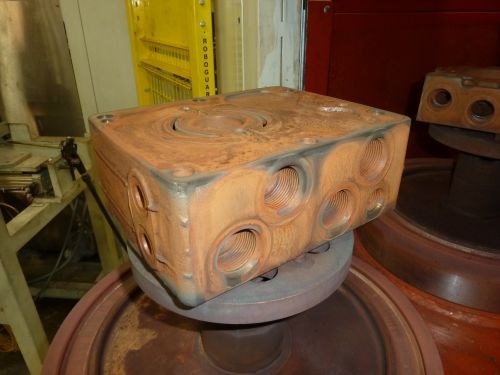Removing Burrs Can Be a Blast
Having trouble deburring the inner passages of a solid metal part? Read about how one company found the solution in Thermal Energy Machining (TEM), and is having a blast in the process.
Share





An oxidized part immediately after undergoing TEM deburring. The residue will be removed during post-washing in a neutral solution.
Lubos Hanulik, product line manager at Danfoss Power Solutions in Ames, Iowa, is an experienced engineer. But he’s also a pretty good teacher. I discovered this while visiting with him to learn—and write an article—about a highly automated cell he helped develop using the Thermal Energy Method (TEM) to burn away burrs in the internal chambers of two components of a hydrostatic transmission. I found this to be a fascinating experience because, not only did I get to learn about TEM deburring, which ignites an oxygen/methane mix that removes burrs via oxidation, but also about the thought process behind creating a machining cell from scratch.
In short, the cell incorporates Mazak HCN 6000 horizontal milling machines, FANUC robots and a custom-designed washer and a P400 five-station TEM machine from Kennametal Extrude Hone to carry castings all the way from initial machining to the finished product. The parts—an end cap and a connector—are then ready for final assembly about 50 yards away. The entire operation is overseen by a single operator.
Although you may have a completely different application, much can be learned from Mr. Hanulik’s approach to developing this cell.
Related Content
-
Tapmatic Showcases Deburring Tool for a Consistent Edge Break
IMTS 2024: Tapmatic Corp. exhibits the DeBurr-Z deburring tool for simplified programming and a consistent edge break.
-
Trumpf Deburring Tool Provides Repeatable Accuracy
The TruTool TKA 1500 edge milling tool is now available with a new cutting mount and guide fence for increased applications and safety.
-
Mastercam Software Improves Programming Flexibility
IMTS 2024: Mastercam introduces Mastercam 2025, with features including Mastercam Deburr for automated edge finishing, finish passes, mill-turn support for Y-axis turning and automatic license update notifications.
















.png;maxWidth=300;quality=90)




.png;maxWidth=970;quality=90)